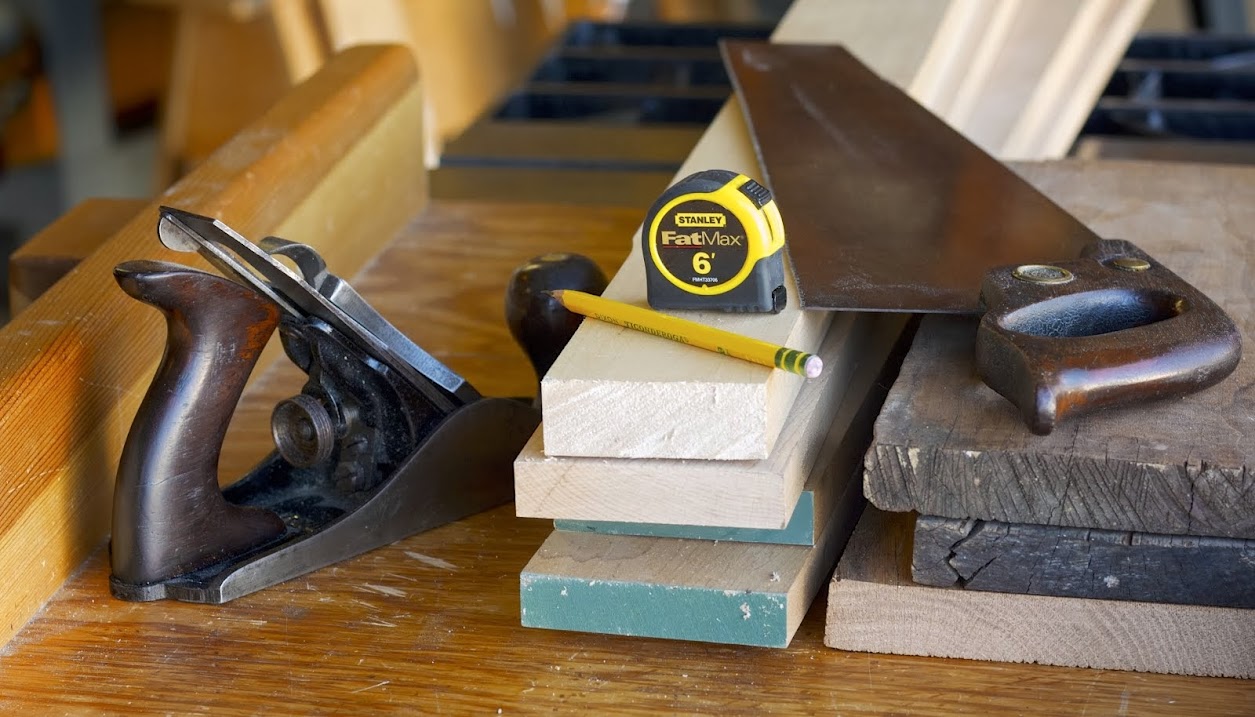I recently built these toddler stools as a gift. Rich, a friend of our son Thad, and his wife, Joy recently had twin boys. Toddler stools make a neat and useful gift for kids especially when personalized with their names. The idea and pattern came from my good friend, Jay. The material is FAS 4/4 maple. I enjoy working with maple because it machines nicely, has minimal waste and leaves a nice smooth surface when finished. The photos can be enlarged by clicking on them.
I began by gluing up boards for making the sides. My portable planer isn't wide enough to handle planing and smoothing the wide surfaces. So, I took them to the Clovis Woodshed where they have a wide belt sander that can handle the glued up boards.
 |
| Material for the Four Sides, Steps, and Risers |
Once the sides were glued, surfaced, and cut to width and length, the next step was to cut dado joints to accept the step and riser. The dado is a common joint used to join pieces for strength and alignment. I like to use the router, set up with a straight bit set to a depth of 1/4". Some folks will cut dados 3/8" deep, but I have found 1/4" works as well with less wear and tear on the bit. The width of the dado cut is determined by the thickness of the piece that fits into it. Since the steps and risers are 3/4" thick, I use a 3/4" bit that is .015 oversize. This allows for a snug fit without squeezing the glue out of the joint.
 |
| Plunge Router with Straight bit and Support Guide for Cutting Dado Joints |
I occasionally make mistakes... Notice the photo below. Somehow the router came away from the guide and look what happened. Luckily, I had some extra material and was able to fashion another side piece.
 |
| Oops! |
Next, the curved edges were freehand cut on the band saw. A little material was left to be trimmed later with a router setup.
 |
| Cutting Curves with the Band Saw |
Band saw cuts are irregular and not smooth. One method of smoothing out the edges is to use a rasp or file. Another method is attach the pattern to the work piece with double sided tape and trim the excess material. A flush trim router bit is used in a router that is attached to the router table. The guide bearing at the top of the bit rides along the edge of the pattern while trimming the excess material. This leaves a clean smooth edge.
 |
| Rounding Over the Side Edges |
The names and my signature were laser etched at the yard where I purchase lumber for projects. It's an interesting process that is controlled by a computer and a laser that burns and etches whatever font or size is programed into the computer. Once the process has started, it is completly automated.
 |
| Laser Etching |
After Sanding all the parts, the next step was assembly. I began by "dry fitting" to be sure all the parts fit. It didn't take very long to realize that gluing, assembling, and clamping five parts at the same time was going to be difficult. After clamping, I added screws for extra strength. The screws were counterbored and wooden plugs glued to hide the screw heads.
The last thing to do was some touch up sanding and finish. With the maple, I wanted a clear satin finish. My friend Jason, at the Clovis Woodshed, recommended using a gel polyurethane. I've heard of these finishes, but never have used one. This finish has the consistency and look of apple jelly. It is the greatest! You simply rub it on with a rag and wipe off the excess with another rag. It's quick, easy, with no runs and drips. I applied three coats and ended up with a nice smooth satin finish.
 |
| It Doesn't Get any Easier than this Stuff |
The stools turned out great and Rich and Joy loved them. That's Lucy, our doxie checking the quality of my work. By the way, I have to give my wife Susan credit for the hand hold underneath the top step. She felt moms needed a convenient handle for moving and lifting the stools.





